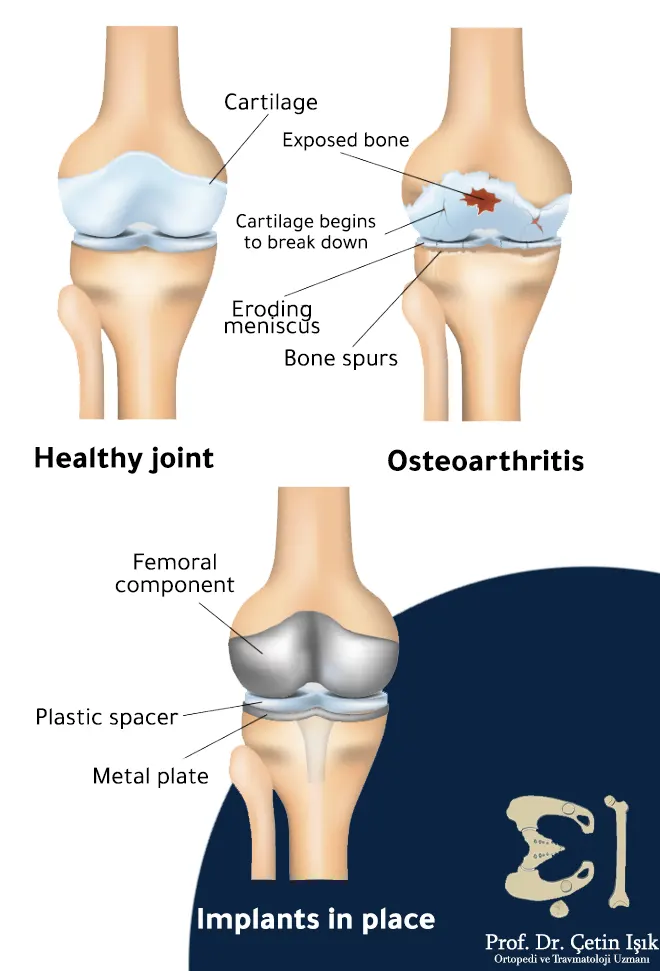Robotic knee joint replacement is one of the most advanced surgeries that require special preparation and quality equipment, and it's not correct that the robot replaces the joint on its own but requires a skilled surgeon to guide it.
What is the robotic knee joint replacement procedure?
Robotic knee joint replacement is similar to traditional knee operations where the consultant orthopedic surgeon removes the damaged tissue in the knee to replace the natural joint and place the artificial joint, and the only difference is that a robotic arm or a portable robotic device is performing the surgery.
Robot-assisted knee surgery allows operations to be performed with higher accuracy in less time, and the use of robotic technology means that the recovery period for the patient of the orthopedic clinic after the operation will be shorter because it preserves the soft tissues better and provides more stability to the knee after the operation.
Best types of artificial knee joints
These joints were used for the first time about two centuries ago, and it was a great medical achievement, as many cases that suffered from severe knee stiffness did not have a cure in the past, as most health centers applied palliative treatment of painkillers and others, and their effectiveness was limited.

In most orthopedic hospitals, certain materials are used to manufacture joints. The types of joints have been divided according to the materials in which they are used:
- Metal and plastic: It is the most common type in the medical center that specializes in joint replacement usually, as it is the least expensive and the longest-lasting, but it can sometimes cause erosion of the cartilage and bone under it, and these accidents have decreased with the development of manufacturing methods.
- Ceramic and plastic: Sometimes, a metal joint is not replaced due to the patient's sensitivity to some metals, so ceramic joints have been created with better properties and less impact on the patient's immunity.
- Ceramic only: In some cases of osteoarthritis, the joint completely damaged is replaced by an artificial ceramic joint.
- Metal only: Its use in medical treatments has decreased significantly during the past ten years, but in the past, it was popular with those who suffer from knee problems and do not wish to replace the joint repeatedly.
People who need robotic knee replacement surgery
Patients who are candidates for traditional knee replacement are often the same patients who can perform operations using a robot, as this technique is exemplary even when performing the most complex procedures, which include:
- تشوهات عظم الركبة بعد الإصابات
- Complex joint degeneration
- Injury as a result of previous operations
Robotic knee joint replacement is one treatment options that preserve knee ligaments. There is a unique technique in which all ligaments are preserved, which gives the patient the ability to move smoothly, especially for patients who:
- Their daily activities require significant physical activity, such as sports.
- Their bones are intact before surgery.
- Their ligaments are also functional and intact before surgery.

A radiograph showing the artificial joint in the knee after its implantation, where the ligaments, bones, and muscles appear relatively healthy
Reasons for replacing the knee joint
The most common indication for robotic knee replacement surgery is severe osteoarthritis pain, but your doctor may suggest knee surgery when:
- The knee joint suffers from severe pain that awakens the patient from sleep.
- The patient cannot walk or the seek care of himself.
- The pain has not improved with the use of analgesics or with conservative treatment methods.
- The patient understands the importance of the surgery and the time it will take to recover.
Knee replacement surgery for the elderly
Although the robotic knee replacement is a major surgery that requires several weeks to heal, no age limit prevents the patient from undergoing robotic knee operations.
Many studies have shown that patients in their eighties and even nineties benefit from knee joint replacement operations as much as younger patients. Therefore, conditions in which this type of surgery isn't recommended aren't familiar.
Downsides of robotic knee replacement surgery and its complications
Bone and joint complications after knee replacement surgery include:
- Fractures of the endoscopic hole site
- Infections at the site of the endoscopic hole
- Iatrogenic injury
- More blood loss
- Articular stiffness
Do not hesitate to Contact us to learn more about robotic surgery and its applications in orthopedics.
Sources:
- PennMedicine
- National Library of Medicine
- Medline Plus
- Harvard Health Publishing
- Cleveland Clinic
- BioMed Central
Common questions
Knee joint operations are generally considered safe, and when the operation is performed using a robot, the risk of side effects is reduced by 5%.
It almost reaches 100%, and 95% patients do not suffer from any disturbing problems or complications.
It costs an average of between 5,500 and 15,000 dollars, and in Turkey it reaches an average of 10,000 dollars, as it is more expensive than arthroscopic knee replacement.
It ranges between 1,000 and 2,000 dollars.
As a result of inflammation occurring in the place of the knee joint and disappears after several weeks.
An hour to two hours.




